18 October 2017
VGFC 2017: Limbs of arkose
Posted by Callan Bentley
This past weekend was the annual Virginia Geological Field Conference, hosted by Piedmont Virginia Community College, with a field trip led by Chuck Bailey, Megan Flansburg, Katie Lang, and Tom Biggs. We examined the geology of Albemarle County, Virginia, the county that surrounds Charlottesville. This is the Blue Ridge province; the county spans its width almost exactly. We began on the east limb of the Blue Ridge Anticlinorium, traversed its basement rocks (exposed in the middle of the big fold) and ended on the western limb, adjacent to the northern terminus of the Blue Ridge Parkway and the southern end of Shenandoah National Park.
If there was a theme for the day, it was “arkose.” There’s a lot of feldspar-rich sand that was deposited in central Virginia during the Neoproterozoic. Though the formations vary, the (meta-)arkosic flavor carries through the Lynchburg Group. A few examples:


Here’s a boulder contrasting the typical lichen-encrusted outer surface with a fresh face:
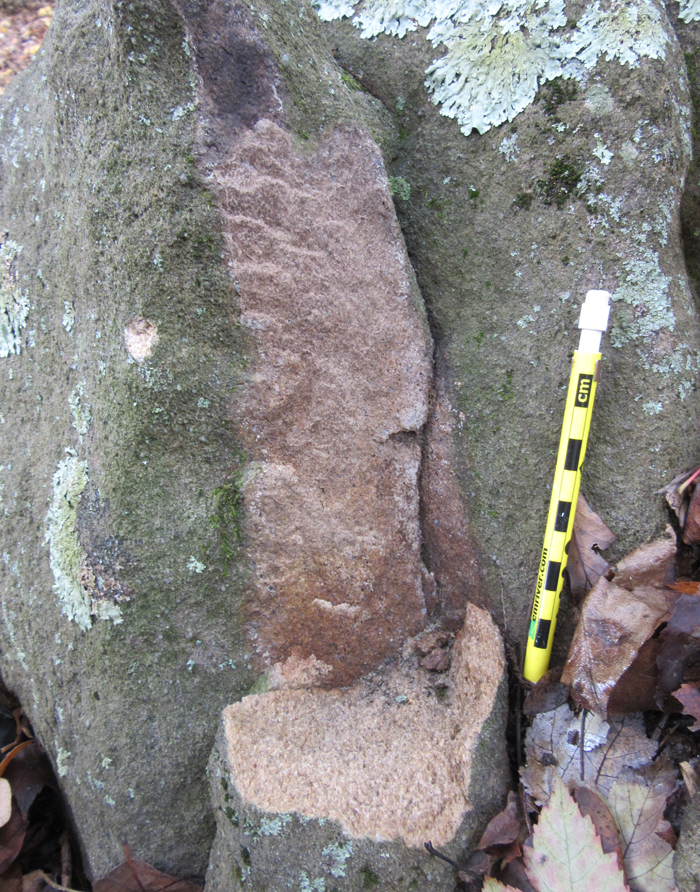
We visited the Mechum River Formation (worth a blog post in its own right since it appears to be glaciogenic), but I didn’t taken any new photos on Saturday.
There were also a few fine-grained units, like these lovely pelitic metasediments, now hosting substantial garnets:
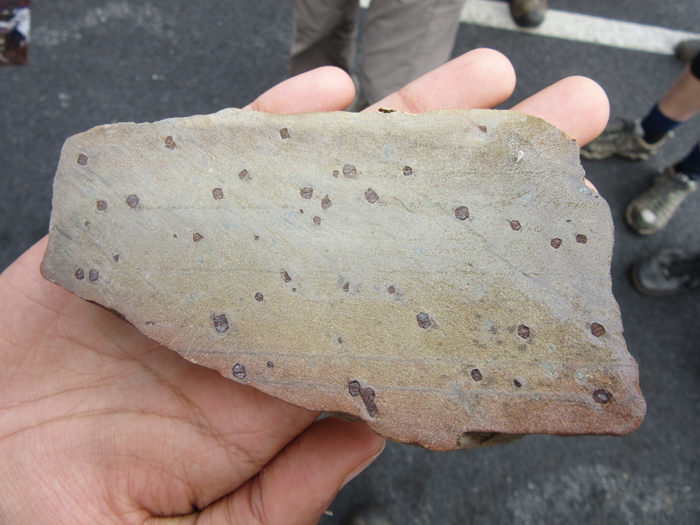

At a highway entrance ramp I’ve traversed dozens of times without stopping, I got to examine pelitic layers within the arkose. Here you can see the contact as an arcuate feature dipping to the right in the photo:

…Zooming in:

Here’s that contact annotated, in case it’s a wee bit too subtle:
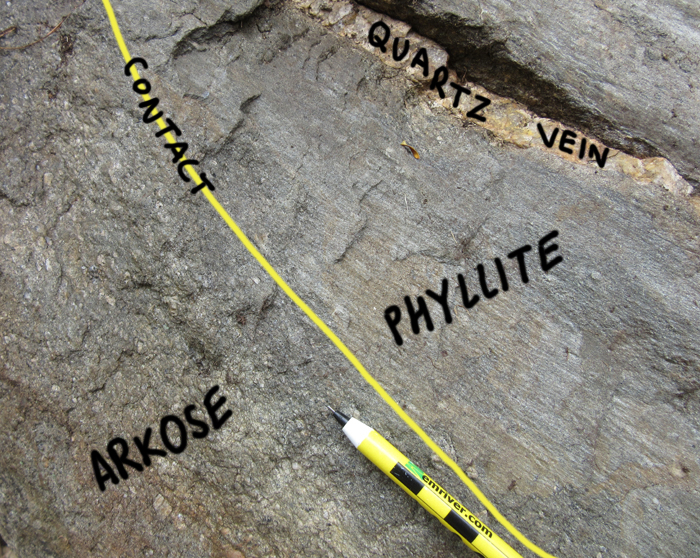
The pelite here has been metamorphosed to a phyllite, and bears small crenulated wrinkles:

Even the arkose at this site had a phyllitic matrix, as you can see from the tilting back and forth of this cut and polished sample:
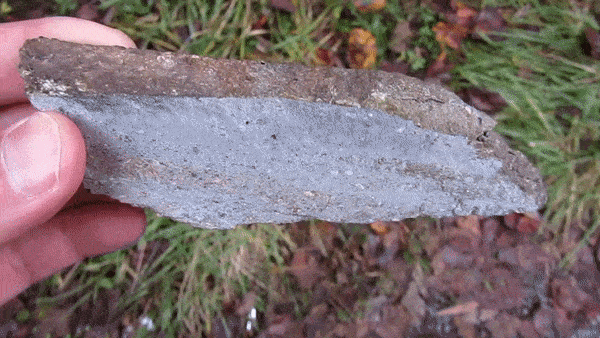
At another site, we saw an unusual combination of finely interbedded arkosic sand and graphitic phyllite:

Whatever the depositional setting was for these sediments, there was a lot of organic carbon getting added to the mix. A “bayou” type setting with distributary channels was hypothesized as one explanation.
Cut samples and fresh rock from the site, the first showing the arkose mixed with graphite rich beds at the base:

More graphitic, but still sand dominated:

Here’s one dominated by graphite with a lesser amount of intercalated sand:

Nothing but graphite:

At the final stop up on the Blue Ridge itself, we saw coarse arkosic sediments within the Catoctin Formation, which is otherwise dominated by greenstone (meta-basalt):

Contact between medium and coarse grained dark gray arkose:

Here’s the contact between the greenstone (below) and the arkose above:

It appears to be unconformable on the basis of the wiggly, undulating contact, but the facing indicators were insufficient to convince me that I could tell which way was paleo-up. So I’m not sure if this is the bottom of the arkose or the top (and then bedding was overturned, which is something reasonable to expect in the western Blue Ridge). Annotated:
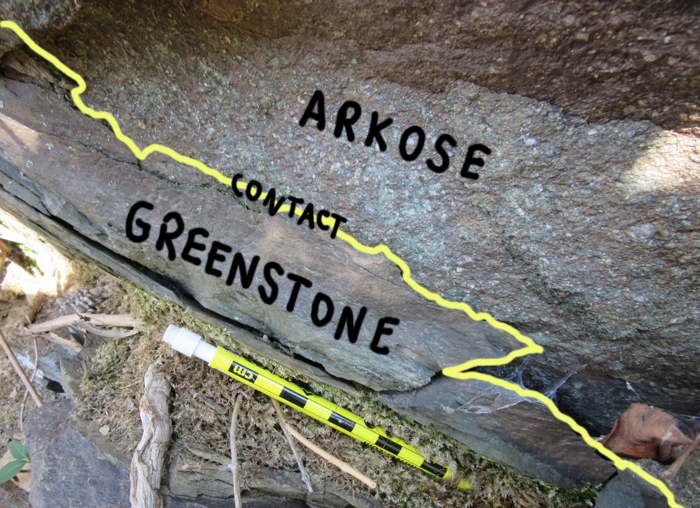
I have a few more images from the trip to share, but they have a different theme, so I’ll save them for another post.


 Callan Bentley is Associate Professor of Geology at Piedmont Virginia Community College in Charlottesville, Virginia. He is a Fellow of the Geological Society of America. For his work on this blog, the National Association of Geoscience Teachers recognized him with the James Shea Award. He has also won the Outstanding Faculty Award from the State Council on Higher Education in Virginia, and the Biggs Award for Excellence in Geoscience Teaching from the Geoscience Education Division of the Geological Society of America. In previous years, Callan served as a contributing editor at EARTH magazine, President of the Geological Society of Washington and President the Geo2YC division of NAGT.
Callan Bentley is Associate Professor of Geology at Piedmont Virginia Community College in Charlottesville, Virginia. He is a Fellow of the Geological Society of America. For his work on this blog, the National Association of Geoscience Teachers recognized him with the James Shea Award. He has also won the Outstanding Faculty Award from the State Council on Higher Education in Virginia, and the Biggs Award for Excellence in Geoscience Teaching from the Geoscience Education Division of the Geological Society of America. In previous years, Callan served as a contributing editor at EARTH magazine, President of the Geological Society of Washington and President the Geo2YC division of NAGT.
No chill margin in greenstone nor contact meta in arkose would suggest RSU.
Yeah, that’s an excellent point. Thanks!
I’ll provisionally accept that interpretation 🙂
RSU?
“right-side-up”